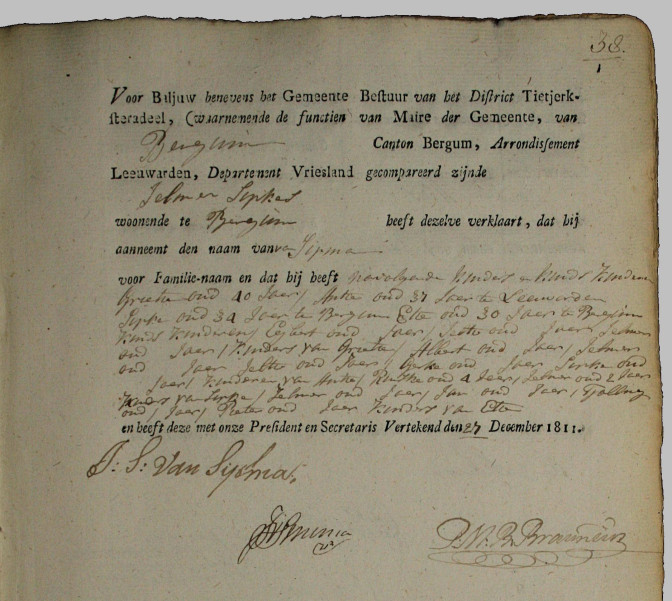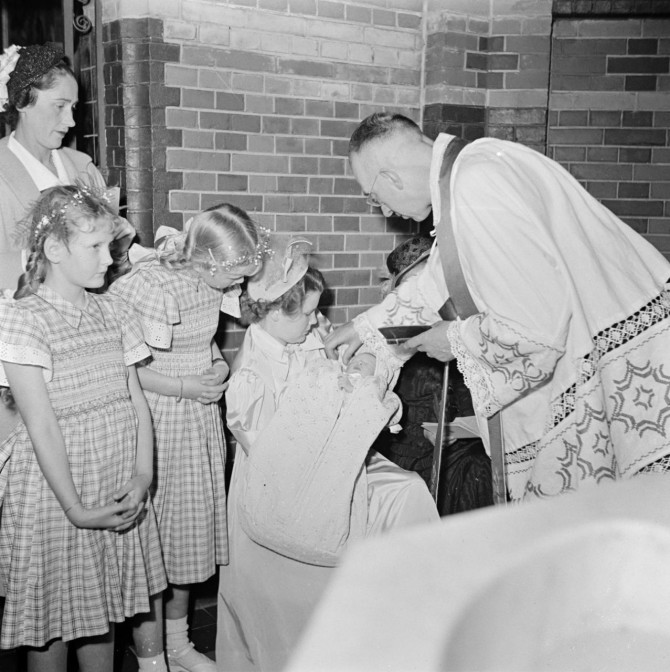I was tagged in a Facebook post asking how to deal with variations of surnames in your genealogy software. Genealogy software typically requires us to choose one name as the default to use in reports and lists, and allows us to enter alternative names. I use three different strategies to select which name to use as the main name, depending on when the person was born. I record other names and major spelling variations as alternative names.
Born after the civil registration
The civil registration of births, marriages, and deaths was introduced in 1811 in most parts of the Netherlands (1794-1796 in some southern parts). If someone has a civil registration birth record, that is the official spelling and I use that as the main spelling of the person’s name. If I come across other spellings, I may enter those as alternative names.
Born before the civil registration, died after introduction of the civil registration
If someone was born before the civil registration, but died after the introduction of the civil registration, I use the spelling in the civil registration. If there is a marriage record, I use that spelling. Otherwise, I use the spelling in the death record or name taking record (if available). I have often found that the spelling in the name taking record did not actually stick so I prefer marriage or death records.

Name taking record of Jelmer Sipkes Sipma. Image credit: Tresoar
Died before the civil registration
Before the civil registration, there was no official spelling. People were free to adopt whatever name they liked. Many people were illiterate and would not have a preference for how their name was spelled. The spelling would be up to the individual record creator.
If someone died before the civil registration, I use the following strategies to pick the main name to use.
- Use the spelling the person themselves used. For example, if I can find a signature, I will use that.
- Use the name in their own language. If a person was Dutch, I try to find their name in a Dutch record, regardless of whether their baptismal and marriage records might be in Latin because they were Roman Catholic. They would have used their Dutch names in everyday life, so I prefer to use those. But if all I have are the Latin records, I use those. I will change the form to the nominativus (subject) in that case. For example, if someone appears with a first name Petri (genitive form) in a baptismal record of their child, that means “of Petrus” and I will use Petrus as the first name. Similarly, I will use Maria instead of Mariae.
- Use the name that was most frequently used. If the person appears in records with different variations of the name, I go with the most common spelling for the main. That applies to someone who spells their own name differently too: I go with the most common variation.
What about baptismal records?
I know some people like to use the spelling in baptismal records, to be consistent with using the birth record after the civil registration. If the baptismal record has a Dutch name that the person uses later in life, that is fine to use. But here are my reasons for not always using that spelling:
- Baptismal records can be in a different language than the person or their parents would use, like the Latin example I gave above.
- Baptismal records may not reflect the name the persons used themselves. For example, on my father’s side, most of my ancestors used farm names that changed every time they moved. The baptismal record may have captured a name the family only used for a short time.
- Baptismal records may not have a last name. In several regions, people used patronymics instead or in addition to last names. For example, a record may say a child was Maria, daughter of Peter Jacobs and Christina Peters. That does not tell me what name Maria used. She could have used Peters, since she was the daughter of Peter, or Jacobs may have become a last name already and she may have used Maria Jacobs, or a different name like de Witte if her family used a surname but the baptismal record did not use that.

Baptism of a child, 1956. Credits: Willem van de Poll, collection Nationaal Archief (CC-BY)
Inconsistencies in software
My strategy will lead to spelling variations over time, where different members of the same family have different forms of the name for their main name. I personally prefer it this way, since it shows how names changed over time. I do not want to anachronistically assign someone a modern spelling just because it will look nicer in my program. For example, my own last name of Hoitink originally had a ‘k’-sound in the middle instead of a t. And originally the i was ij and the k was ck. The earliest forms I have found are variations of Hoijckijnck. I would not call these people Hoitink since they never used that name and were never recorded by that name.


I really like “Hoijckijnck”, as daunting as it might appear. 🙂
This was a terrific post and has a lot of useful suggestions, thank you! I’ve tended to do a lot of what you’ve suggested, but see that there are other factors to consider that has me evaluating my system of recording names and whether I need to tweak things a bit.
The oldest variation I’ve found of my surname is “van der Fluijt”, with one instance of “van der Fleuyt” form the 1600s. That one surprised me with the “y”, but I wouldn’t be surprised it was actually an “ij” in the original document (I haven’t seen the original document, it came from a distant cousin in the Netherlands who had seen the record). What surprises me the most is how many different meanings “fluit” can have. As romantic as it would be to think it is a reference to a fast sailing ship, I suspect it has more to do with cow parsley. 😛
This is a great post. I would add, certainly from my own experience, that many of us rely on transcribed records in digital databases, frequently not (closely) looking at the digital scan. After al, that is even more work, and requires skills in accurately interpreting old hand writing.
That introduces one more variable in the mix: the transcribers decisions. For example, on more than one occasion I found a transcriber using “y” instead of what I would consider reading myself in the image as a “ij”. As far as I know, but I am not an expert at all, “ij” was long considered a single letter in the Dutch alphabet (and certainly my Dad’s typewriter has it on a single key), although in the computer age it is reproduced using two individual letters. Centuries ago “y”, if it existed at all, was more a substitute for an “i” type sound. So when I read a transcribed name such as “Berckhey” in the 1600-1700 time frame I am almost sure that the original was (meant to be?) “Berckheij”, which today would most likely have become “Berkhij”.
I have also seen instances of the transcriber “modernizing” the original written name, turning “Annigje” in the written record into “Anneke” in the digital database.
So if I don’t re-read the scan myself, I record the name, as spelled in the transcribed record, as one of the alternatives, regardless of what I decided to use as the “main” spelling. I also do this and record source references with each alternative spelling. After all, finding those records back, in the original database, is easiest by searching for that precise variation. I do sometimes end up with individuals with a dozen or so name variations, all essentially meaning the same thing to a modern Dutch speaker, yet all different spelling variations.
There did not used to be a difference between y and ij in the Dutch language. All the words with y in the modern dictionary are borrowed from other languages, like baby or hobby. So in old records, it is the same letter whether they rendered it as y, ij (one letter in a ligature) or ij (two letters).